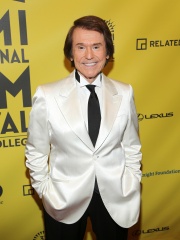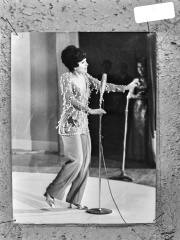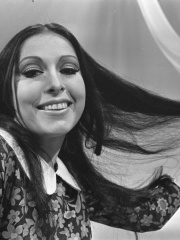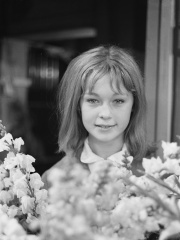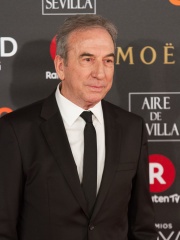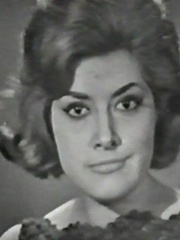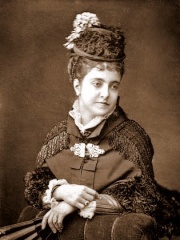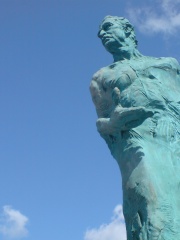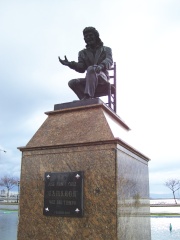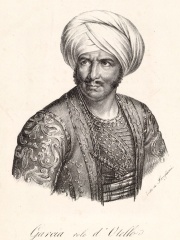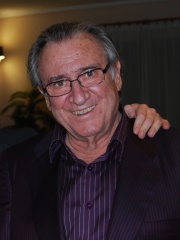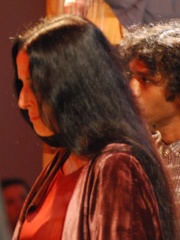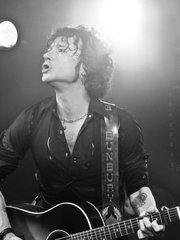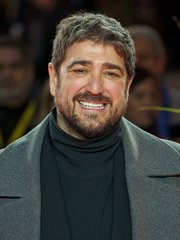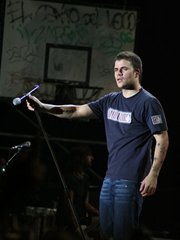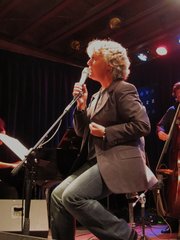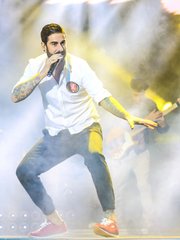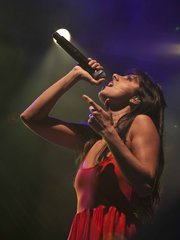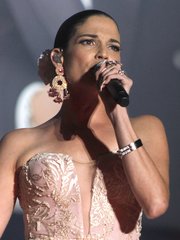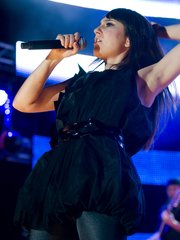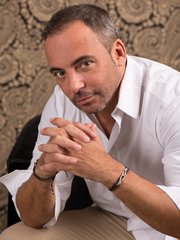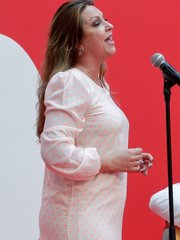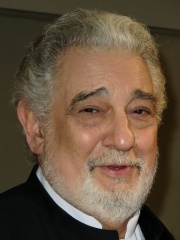
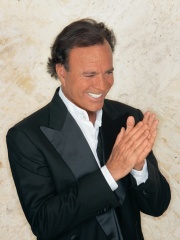
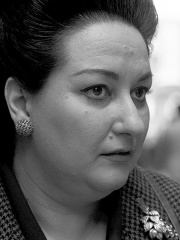
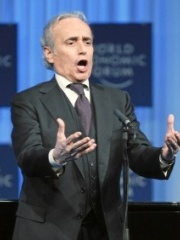
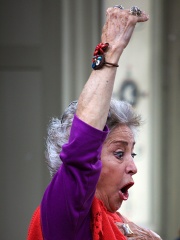
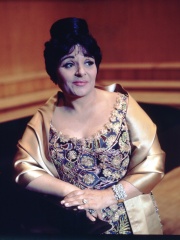
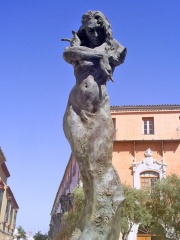
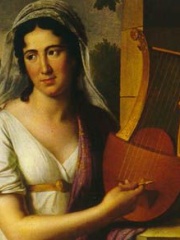
The Most Famous
SINGERS from Spain
Top 10
The following people are considered by Pantheon to be the top 10 most legendary Spanish Singers of all time. This list of famous Spanish Singers is sorted by HPI (Historical Popularity Index), a metric that aggregates information on a biography's online popularity. Visit the rankings page to view the entire list of Spanish Singers.

1. Plácido Domingo (b. 1941)
With an HPI of 80.52, Plácido Domingo is the most famous Spanish Singer. His biography has been translated into 72 different languages on wikipedia.
José Plácido Domingo Embil (born 21 January 1941) is a Spanish opera singer, conductor, and arts administrator. He has recorded over a hundred complete operas and is well known for his versatility, regularly performing in Italian, French, German, Spanish, English and Russian in the most prestigious opera houses in the world. Although primarily a lirico-spinto tenor for most of his career, especially popular for his Cavaradossi, Hoffmann, Don José and Canio, he quickly moved into more dramatic roles, becoming the most acclaimed Otello of his generation. In the early 2010s, he transitioned from the tenor repertory into exclusively baritone parts, including Simon Boccanegra. As of 2020, he has performed 151 different roles. Domingo has also achieved significant success as a crossover artist, especially in the genres of Latin and popular music. In addition to winning fourteen Grammy and Latin Grammy Awards, several of his records have gone silver, gold, platinum and multi-platinum. His first pop album, Perhaps Love (1981), spread his fame beyond the opera world. The title song, performed as a duet with country and folk singer John Denver, has sold almost four million copies and helped lead to numerous television appearances for the tenor. He also starred in many cinematically released and televised opera movies, particularly under the direction of Franco Zeffirelli. In 1990, he began singing with fellow tenors Luciano Pavarotti and José Carreras as part of The Three Tenors. The first Three Tenors recording became the best-selling classical album of all time. Growing up working in his parents' zarzuela company in Mexico, Domingo has since regularly promoted this form of Spanish opera. He also increasingly conducts operas and concerts and was the general director of the Los Angeles Opera in California from 2003 to 2019. He was initially the artistic director and later general director of the Washington National Opera from 1996 to 2011. He has been involved in numerous humanitarian works, as well as efforts to help young opera singers, including starting and running the international singing competition, Operalia. Since 2019 he has performed continuously on stages in Berlin, Budapest, Cologne, Graz, Madrid, Mérida, Milan, Monte Carlo, Moscow, Munich, Palermo, Rome, Salzburg, Sofia, Verona, Versailles, Vienna and Zurich.

2. Julio Iglesias (b. 1943)
With an HPI of 80.18, Julio Iglesias is the 2nd most famous Spanish Singer. His biography has been translated into 79 different languages.
Julio José Iglesias de la Cueva (Spanish: [ˈxuljo jˈɣlesjas]; born 23 September 1943) is a Spanish singer and songwriter. Iglesias is recognized as the most commercially successful Spanish singer in the world and one of the top record sellers in music history, having sold more than 300 million records worldwide in 14 languages. It is estimated that during his career he has performed in more than 5,000 concerts, for over 60 million people in six continents. In April 2013, Iglesias was inducted into the Latin Songwriters Hall of Fame. In 1983, Iglesias was credited as having recorded songs in the most languages in the world, and in 2013 for being the best-selling male Latin artist of all-time. In April 2013 in Beijing, he was honoured as the most popular international artist in China. In Brazil, France, Italy and elsewhere, Iglesias is the most successful foreign record seller, while in his home country, Spain, he has sold the most records in history, with 23 million records. During his career, Iglesias has won many awards in the music industry, including the Grammy, Latin Grammy, World Music Award, Billboard Music Award, American Music Award and Lo Nuestro Award. He has been awarded the Gold Medal for Merit in the Fine Arts of Spain and the Legion of Honour of France. UNICEF named him Special Ambassador for the Performing Arts in 1989. He has had a star on the Hollywood Walk of Fame since 1985.

3. Montserrat Caballé (1933 - 2018)
With an HPI of 79.27, Montserrat Caballé is the 3rd most famous Spanish Singer. Her biography has been translated into 77 different languages.
María de Montserrat Bibiana Concepción Caballé i Folch or Folc (12 April 1933 – 6 October 2018), simply known as Montserrat Caballé (i Folch), was a Spanish operatic soprano. Widely considered to be one of the greatest sopranos of the 20th century, she won a variety of musical awards throughout her six-decade career, including three Grammy Awards. Caballé performed a wide variety of roles, but is best known as an exponent of the works of Verdi and of the bel canto repertoire, notably the works of Rossini, Bellini, and Donizetti. She was noticed internationally when she stepped in for a performance of Donizetti's Lucrezia Borgia at Carnegie Hall in 1965, and then appeared at leading opera houses. Her voice was described as pure but powerful, with superb control of vocal shadings and exquisite pianissimo. Caballé is also known for her 1987 duet with Freddie Mercury, "Barcelona", later used for the 1992 Olympic Games. The two had mutual admiration for each other and developed a close friendship.

4. José Carreras (b. 1946)
With an HPI of 78.21, José Carreras is the 4th most famous Spanish Singer. His biography has been translated into 63 different languages.
Josep Maria Carreras Coll (Catalan: [ʒuˈzɛb məˈɾi.ə kəˈreɾəs ˈkɔʎ]; born 5 December 1946), better known as José Carreras (, Spanish: [xoˈse kaˈreɾas]), is a Spanish operatic tenor who is particularly known for his performances in the operas of Donizetti, Verdi and Puccini. Born in Barcelona, he made his debut on the operatic stage at 11 as Trujamán in Manuel de Falla's El retablo de Maese Pedro, and went on to a career that encompassed over 60 roles, performing in the world's leading opera houses and on numerous recordings. He gained fame with a wider audience as one of the Three Tenors, with Plácido Domingo and Luciano Pavarotti, in a series of large concerts from 1990 to 2003. He is also known for his humanitarian work as president of the José Carreras International Leukaemia Foundation (La Fundació Internacional Josep Carreras per a la Lluita contra la Leucèmia), which he established following his own recovery from the disease in 1988.

5. Enrique Iglesias (b. 1975)
With an HPI of 71.35, Enrique Iglesias is the 5th most famous Spanish Singer. His biography has been translated into 88 different languages.
Enrique Miguel Iglesias Preysler (Spanish pronunciation: [enˈrike miˈɣel iˈɣlesjas ˈpɾejsleɾ]; born 8 May 1975) is a Spanish singer and songwriter. He started his recording career in the mid-1990s on the Mexican label Fonovisa where he released three Spanish albums: Enrique Iglesias, Vivir and Cosas del Amor, becoming the bestselling Spanish-language act of the decade. By the turn of the millennium, he made a successful crossover into the mainstream English-language market. He signed a multi-album deal with Universal Music Group for US$68 million with Interscope Records releasing a string of hit English albums such as Enrique, Escape, 7 and Insomniac. During this time he also released Spanish albums such as Quizás and 95/08 Éxitos under Universal Music Latin. In 2010, Iglesias parted with Interscope Records and signed with another Universal Music Group label, Republic Records where he released two successful bilingual albums Euphoria and Sex and Love. In 2015, he parted ways with Universal Music Group after over a decade. He signed with Sony Music and his subsequent albums were to be released two more bilingual albums Final (Vol. 1) and Final (Vol. 2) with Sony Music Latin in Spanish and RCA Records in English. Iglesias is one of the best-selling Latin music artists with estimated sales of over 100 million albums worldwide. He has had five Billboard Hot 100 top five singles, including two number-ones. Iglesias holds the record for the most number-one songs on the Billboard Hot Latin Songs chart with 27 songs and the Latin Pop Airplay chart with 24 songs. Iglesias holds the number-one position on the Greatest of All-Latin Artists charts and in October 2022 he was honored with the Top Latin Artist of All Time at the Latin Billboard Awards. Iglesias also has 14 number-ones on Billboard's Dance charts, more than any other male artist. He has earned the honorific title King of Latin Pop. In December 2016, Billboard magazine named him the 14th most successful and top male dance club artist of all time.

6. Teresa Berganza (1933 - 2022)
With an HPI of 68.00, Teresa Berganza is the 6th most famous Spanish Singer. Her biography has been translated into 33 different languages.
Teresa Berganza Vargas OAXS (16 March 1933 – 13 May 2022) was a Spanish mezzo-soprano. She is most closely associated with roles such as Rossini's Rosina and La Cenerentola, and later Bizet's Carmen, admired for her technical virtuosity, musical intelligence, and beguiling stage presence. Berganza was a key singer in a Rossini renaissance which explored less-performed operas and restored the leading roles to mezzo register. She appeared as Zerlina in Joseph Losey's Don Giovanni film in 1979. She participated in the opening ceremonies of the Expo '92 in Seville and of the 1992 Summer Olympics in Barcelona.

7. Victoria de los Ángeles (1923 - 2005)
With an HPI of 66.82, Victoria de los Ángeles is the 7th most famous Spanish Singer. Her biography has been translated into 31 different languages.
Victoria de los Ángeles López García (1 November 1923 – 15 January 2005) was a Spanish operatic lyric soprano and recitalist whose career began after the Second World War and reached its height in the years from the mid-1950s to the mid-1960s.

8. Lola Flores (1923 - 1995)
With an HPI of 64.84, Lola Flores is the 8th most famous Spanish Singer. Her biography has been translated into 37 different languages.
María Dolores "Lola" Flores Ruiz (Spanish pronunciation: [ˈlola ˈfloɾes]; 21 January 1923 – 16 May 1995) was a Spanish actress, bailaora (flamenco dancer) and singer. Born in Jerez de la Frontera, Flores became interested in the performing arts at a very young age. Known for her overwhelming personality onstage, she debuted as a dancer at age sixteen at the stage production Luces de España, in her hometown. After being discovered by film director Fernando Mignoni, Flores moved to Madrid to pursue a professional career in music and film, with her first gig being the lead role in Mignoni's Martingala (1940). Flores succeeded as a film and stage actress. In 1943 she obtained her breakthrough role in the musical stage production Zambra alongside Manolo Caracol, in which she sang original compositions by Rafael de León, Manuel López-Quiroga Miquel and Antonio Quintero, including "La Zarzamora" and "La Niña de Fuego", mostly singing flamenco music, copla, rumba and ranchera. She then started to receive widespread media coverage. In 1951, Flores signed a five-film contract with Suevia Films for a value of 6 million pesetas, which became the largest contract for a performing artist in Spanish history. Under that contract she starred in major productions like La Niña de la Venta (1951), ¡Ay, Pena, Penita, Pena! (1953), La Danza de los Deseos (1954) and El Balcón de la Luna (1962), among many others, which spawned the signature songs "A tu Vera" and "¡Ay, Pena, Penita, Pena!". Since then, she was popularly dubbed as la Faraona ("the Pharaoh"). During her life, Flores performed in more than 35 films, pigeonholed, in many of them, in Andalusian folklore. As a bailaora, Flores enraged several generations of continents, although she distanced herself from flamenco canons. She also recorded over twenty albums, which she toured through Europe, Latin America and the United States. Her strong personality, recognizable image, remarkable professional trajectory and sometimes controversial personal life, have turned Flores into a Spanish pop culture icon. She is often cited as the "biggest exporter of Andalusian culture to date" as well as a "pioneer", being tributed many times in recent television series and documentaries such as the biographical film Lola, la Película (2007). Lola became the matriarch of what would later be the Flores family, filled with popular singers and television personalities such as Lolita Flores, Rosario, Alba Flores and Elena Furiase. In 1995, Lola Flores died, aged 72, in Alcobendas due to health complications caused by a breast cancer.

9. Isabella Colbran (1785 - 1845)
With an HPI of 64.48, Isabella Colbran is the 9th most famous Spanish Singer. Her biography has been translated into 23 different languages.
Isabella Angela Colbran (2 February 1785 – 7 October 1845) was a Spanish opera soprano and composer. She was known as the muse and first wife of composer Gioachino Rossini.
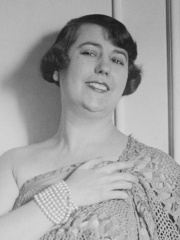
10. Elvira de Hidalgo (1891 - 1980)
With an HPI of 64.34, Elvira de Hidalgo is the 10th most famous Spanish Singer. Her biography has been translated into 20 different languages.
Elvira Juana Rodríguez Roglán (December 28, 1891 – January 21, 1980), known professionally as Elvira de Hidalgo, was a prominent Spanish coloratura soprano, who later became a teacher and vocal coach. Her most famous pupil was Maria Callas.
People
Pantheon has 110 people classified as Spanish singers born between 1775 and 2007. Of these 110, 84 (76.36%) of them are still alive today. The most famous living Spanish singers include Plácido Domingo, Julio Iglesias, and José Carreras. The most famous deceased Spanish singers include Montserrat Caballé, Teresa Berganza, and Victoria de los Ángeles. As of April 2024, 15 new Spanish singers have been added to Pantheon including Enrique Bunbury, Antonio Orozco, and Dani Martín.
Living Spanish Singers
Go to all RankingsPlácido Domingo
1941 - Present
HPI: 80.52
Julio Iglesias
1943 - Present
HPI: 80.18
José Carreras
1946 - Present
HPI: 78.21
Enrique Iglesias
1975 - Present
HPI: 71.35
Raphael
1943 - Present
HPI: 63.69
Salomé
1939 - Present
HPI: 63.37
Massiel
1947 - Present
HPI: 62.19
Joselito
1943 - Present
HPI: 60.24
Marisol
1948 - Present
HPI: 58.87
José Luis Perales
1945 - Present
HPI: 58.72
Alejandro Sanz
1968 - Present
HPI: 57.94
Conchita Bautista
1936 - Present
HPI: 57.22
Deceased Spanish Singers
Go to all RankingsMontserrat Caballé
1933 - 2018
HPI: 79.27
Teresa Berganza
1933 - 2022
HPI: 68.00
Victoria de los Ángeles
1923 - 2005
HPI: 66.82
Lola Flores
1923 - 1995
HPI: 64.84
Isabella Colbran
1785 - 1845
HPI: 64.48
Elvira de Hidalgo
1891 - 1980
HPI: 64.34
Adelina Patti
1843 - 1919
HPI: 64.18
Alfredo Kraus
1927 - 1999
HPI: 63.23
Camarón de la Isla
1950 - 1992
HPI: 62.82
Manuel García
1775 - 1832
HPI: 61.56
Manolo Escobar
1931 - 2013
HPI: 60.74
Montserrat Figueras
1942 - 2011
HPI: 60.37
Newly Added Spanish Singers (2025)
Go to all RankingsEnrique Bunbury
1967 - Present
HPI: 50.68
Antonio Orozco
1972 - Present
HPI: 45.17
Dani Martín
1977 - Present
HPI: 44.84
Mayte Martín
1965 - Present
HPI: 44.80
Melendi
1979 - Present
HPI: 44.61
Mala Rodríguez
1979 - Present
HPI: 43.98
Natalia Jiménez
1981 - Present
HPI: 43.96
Eva Amaral
1972 - Present
HPI: 43.35
Paula Ribó
1990 - Present
HPI: 43.02
Bad Gyal
1997 - Present
HPI: 42.41
Marcos Llunas
1971 - Present
HPI: 41.46
Niña Pastori
1978 - Present
HPI: 41.25
Overlapping Lives
Which Singers were alive at the same time? This visualization shows the lifespans of the 25 most globally memorable Singers since 1700.

